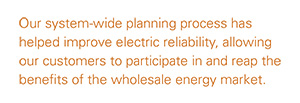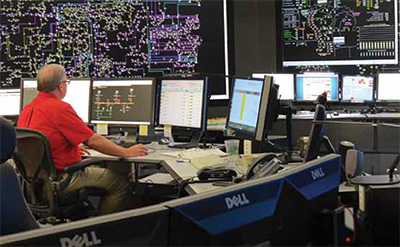Our progress
 While our top priority has always been electric reliability, our mission today is somewhat different than when we began operations on day one in 2001. At first, our efforts focused on connecting the major components of a fragmented system that was created after the founding utilities pooled their assets to form ATC. There was little incentive for those transmission owners to make investments in the system and it was geographically constrained by Lake Michigan and Lake Superior. Now, after $3.8 billion in investments, we have a grid that enables our customers to participate in and reap the benefits of the wholesale energy market.
While our top priority has always been electric reliability, our mission today is somewhat different than when we began operations on day one in 2001. At first, our efforts focused on connecting the major components of a fragmented system that was created after the founding utilities pooled their assets to form ATC. There was little incentive for those transmission owners to make investments in the system and it was geographically constrained by Lake Michigan and Lake Superior. Now, after $3.8 billion in investments, we have a grid that enables our customers to participate in and reap the benefits of the wholesale energy market.
As we continue to use our system‑wide planning process to effectively and economically improve reliability, more emphasis is being placed on the need to efficiently maintain and upgrade our older assets. Our asset management program is focused on the life-cycle management of transmission assets. The objective is to ensure assets perform the required function in a sustainable manner while managing life-cycle cost. Coordination of design, commissioning, operation, maintenance and replacement strategy is crucial to developing the replacement strategy of the asset life cycle. Asset renewal is driven by public and worker safety, regulatory compliance, reliability and operational performance.
Our system-wide planning process has helped improve electric reliability, allowing our customers to participate in and reap the benefits of the wholesale energy market.
Due in large part to our asset management efforts, our reliability has remained best‑in‑class in several industry benchmarking studies. In 2015, we achieved top decile performance for components operating at 69 kV and between 100 and 161 kV, along with top quartile for the 345‑ to 500‑kV voltages classes.
 Our single‑focus, transmission‑only business model has produced significant results for our customers over the years.
Our single‑focus, transmission‑only business model has produced significant results for our customers over the years.
Since we were formed in 2001, we have:
- Upgraded more than 2,130 miles of transmission line,
- Improved 181 electric substations,
- Built 51 new transmission lines (679 miles),
- Connected 6,000 MW of new generation at 25 sites,
- Saved customers more than $100 year in reduced energy costs with access to the marketplace and lower line losses,
- Increased import and export capability, and
- Improved transmission reliability.
